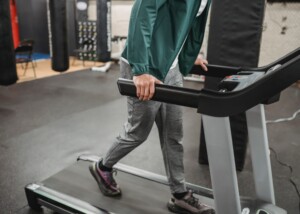
How does a slow jog compare to a regular jog when it comes to fitness and calories burned?
“If your speed is staying constant, then walking vs. running will simply come down to a difference in form,” says Dani Singer, CPT, fitness director for Fit2Go Personal Training.
“Walking is the safer option, as it avoids the impact on the joints and lessens the risk of falling.
“On the other hand, jogging will require a little more aerobic effort (meaning more calories burned and pounds lost) and incorporate more muscle groups.
“So, put simply, walking is the safer workout, whereas jogging is the better one.”
If you’re obese and want to burn as many calories as possible, then the way to do this is with a slow jog.
However, jogging can be a problem for overweight people, so they should first start out with walking.
A slog jog can be done at three mph on a treadmill. But walking can also be done at three mph.
An overweight or very deconditioned lighter person may want to alternate between slow jogging and walking at the same speed.

Shutterstock/LightField Studios
That same speed may also be 2.5 mph or even two mph, since three mph will be taxing to a very overweight person who’s new to sustained walking.
In fact, walking at three mph for an obese person could be more tiring, in a way, than jogging at this same speed.
The jogging will bring out its unique demands, but those demands will be a change from the demands of forcing a very heavy body to sustain the relatively fast pace of three mph.
The best way to train, then, is to have a mixture of jogging and walking at the same speed.
If jogging or walking at a particular speed is just too uncomfortable, than slow the speed so that you can do both jogging and walking.
Of course, there’s always the option to change speeds back and forth when you switch the activity. That’s perfectly fine too.
Avoid this Saboteur of Weight Loss and Fitness
But whatever you do during your treadmill exercise, DO NOT HOLD ONTO THE TREADMILL. Even if you weigh over 300 pounds.

Credit: Alie Greeley
Very overweight (or thinner very out of shape) people desperately need to improve their ambulatory efficiency for the activities of daily living.
Just how is holding onto the treadmill for support going to make your body more efficient at moving around in the daily activities of life – where there is nothing to cling onto for support?
When you do housework, walk across parking lots, walk around at work…there is nothing helping your body stay supported! I’m assuming you don’t use a cane.
Holding onto a treadmill is a DOWNGRADE. It is below your baseline everyday walking! It’s a huge mistake.
Do not give into this temptation, even if most people at the gym are doing it.
Popularity doesn’t make holding onto a treadmill smart. A mistake can be popular.
Whether your goal is to lose fat, get fit, improve heart function, strengthen joints and bones, lower blood pressure, have more wind…you should mix up jogging and walking, either at the same speed or varying speeds.
If you’re already using a treadmill and holding on, here’s how to overcome “intimidation” of jogging on the treadmill.

 Dani Singer is a fitness expert for national publications such as Reader’s Digest and Muscle & Fitness, and teaches hundreds of thousands of trainers as an advisor to the Personal Trainer Development Center.
Dani Singer is a fitness expert for national publications such as Reader’s Digest and Muscle & Fitness, and teaches hundreds of thousands of trainers as an advisor to the Personal Trainer Development Center. 























